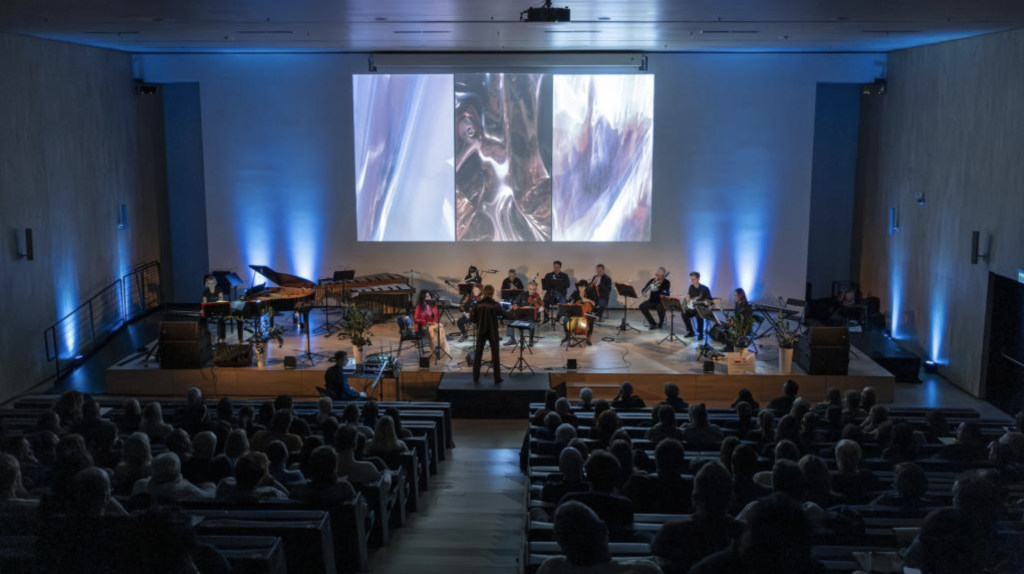KPO for Culture

New venues for new music - or taming the unknown
One of the employees of a cultural institution with which we sometimes collaborate said recently that it is easier for his team to organise and promote a large concert with an open-air stage or a show for several hundred people than a concert of contemporary music using new technologies. In the first case, almost everything is predictable: it is possible to determine the amount of work needed to prepare the event and the amount of equipment that is needed. It is also clear what conditions need to be met for everything to work and for the audience to be happy.
Organising a new music concert is no longer so simple and predictable. Composers today use specialised electronic equipment, sophisticated software dedicated to music, sometimes based on proprietary applications, - and if they do use typical equipment, they usually use it in a non-standard way. This is sometimes frustrating for production teams accustomed to a traditional approach to handling cultural events. This is why presentations of contemporary works - especially the most technologically complex ones - are mainly realised in large music institutions with the appropriate infrastructure or at festivals whose organisers work with experienced production teams.
Technology, however, is constantly advancing and some of the works which not long ago required erecting walls with computers, installing heavy projection equipment, laying out several hundred metres of cables and providing appropriate staff to operate them - are now possible to produce with the help of a laptop with the appropriate software and a few sophisticated electronic devices operated by two or three producers.
Therefore, we decided to check whether, thanks to the available technology, we are already able to organise, on our own, in completely new places, performances of outstanding works of the last decades, which we used to have the opportunity to present at large institutions and music festivals, and whether the experience and know-how gained after almost three decades of artistic activity is enough to realise a technologically complicated concert with the participation of teams with whom we have not previously cooperated.
The occasion for this was the announcement of a call for applications for the ‘KPO for Culture’ programme, one of the main objectives of which is to strengthen the capacity of arts organisations and thus increase their resilience to various kinds of unforeseen crises.
We decided to take advantage of this opportunity and carry out a project that would allow us to increase the mobility of outstanding 21st century works and create the conditions for their presentation in completely new places.
For two years now, we have been testing such possibilities within the framework of annual concerts organised in concert halls of schools and art academies under the name ‘OMN Mobile Residencies’. This time we decided to go further and look for interesting spaces outside concert halls. We have selected some outstanding 21st century works from our repertoire: ‘Black Box Music’, - by Simon Steen-Andersen, “An Index of Metals”. - Fausto Romitelli, ‘In the Alps’ - by Richard Ayres, and ‘Third Space’ by - by Stefan Prins, and we have begun preparations for their presentation in the foyer of the Academy of Fine Arts in Gdansk , the auditorium of the Rialto Cinema Theatre in Katowice and the auditorium of the Silesian Museum in Katowice. Each of these monumental works (lasting between 40 and 60 minutes) is a major artistic, technological and organisational challenge requiring cooperation with the organisers' teams.
So how did the test come about and what are the lessons learned?
Despite the great complication arising from the combination of different technologies (sometimes from 20 years ago) with the latest equipment, all the technical problems were solved and the concerts took place as intended and without artistic compromise. The issue that needs to be resolved (and time) is gaining an audience for these new venues. We thought that the names of the composers and the titles of the works themselves would electrify audiences, who would come in large numbers to hear the ‘cult’ works - known from recordings rather than live performances - and this was partly the case: the audiences at the concerts were by no means empty, but there remained a sense of insufficiency after talking to audiences who said that if they had known it would be such an interesting work they would have brought their family, friends or the class in which they teach to the concert.
Probably one of the most important reasons for this state of affairs is the overabundance of information produced daily by the media and the heavily atomised other media, which makes it difficult for us to find a hierarchy of values for events in the flood of promotional stimuli reaching us. The most eminent artists of the 21st century are no longer icons for the wider public as they were in the 20th century, when - even to a person who did not listen to contemporary music - the names of such artists as Lutosławski, Penderecki or Górecki meant something to them. Today, even in the music community, familiarity with the most frequently performed contemporary works such as Simon Steen-Andersen's ‘Black Box Music’ (almost 80 performances since 2016) - is negligible.
It therefore remains for us to build confidence in our events among potential listeners by presenting high-quality 21st-century works and looking for new ways to reach new audiences, as information alone, even published in large numbers and in the most important media, is no longer enough in the times of the ‘civilisation of excess’ in which we have come to live.
